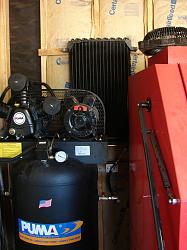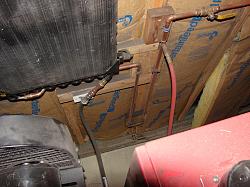Here is a post that I added to hotrodders.com.
New compressor
I picked up this 2 stage air compressor off e-bay. I added an automotive AC condenser to my old compressor and it worked quite well, so I added the home made condenser to the new compressor. It is simple but effective. The condenser is on the unloader side of the system, and when the condenser bleeds off air down to about 5 psi the filter opens and spits out any water in the system. Thus the little container to catch the water.
Since I kept my older compressor I installed a set of circuit breakers with a flipper between them so that only one can be turned on at a time. I also added the hour meters to keep track of service time.
What I used was an AC condenser off a car. I rerouted the compressor to tank line through the condenser and an air water separator I got at Lowe’s. I use the Lowe’s air water separator as at low pressure they will dump the water. I also added a 20” box fan to the back of the condenser and wired it into one lead of the compressor switch, so the fan would turn on whenever the compressor ran.
I later bought a 2 stage compressor and built a condenser out of ¾” baseboard radiator tube.
I can get more photos if needed.
Attachment 14231Attachment 14232Attachment 14233Attachment 14234Attachment 14235

 LinkBack URL
LinkBack URL About LinkBacks
About LinkBacks



 Reply With Quote
Reply With Quote




Bookmarks